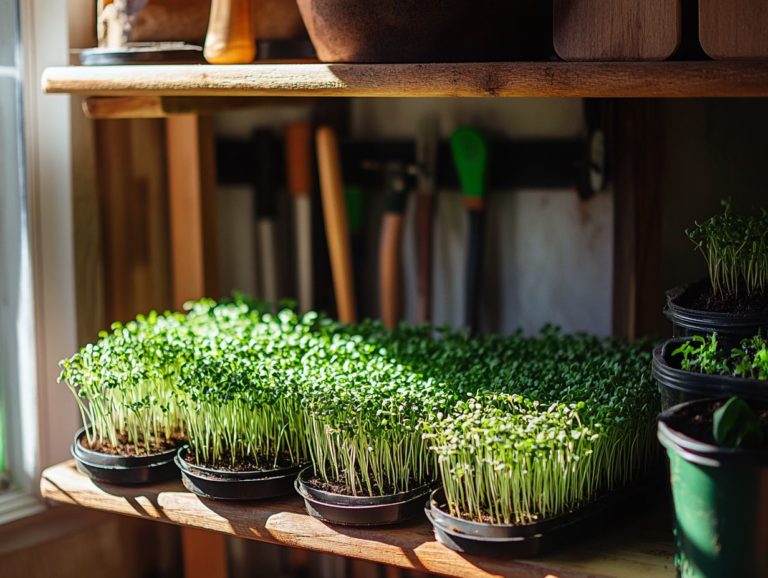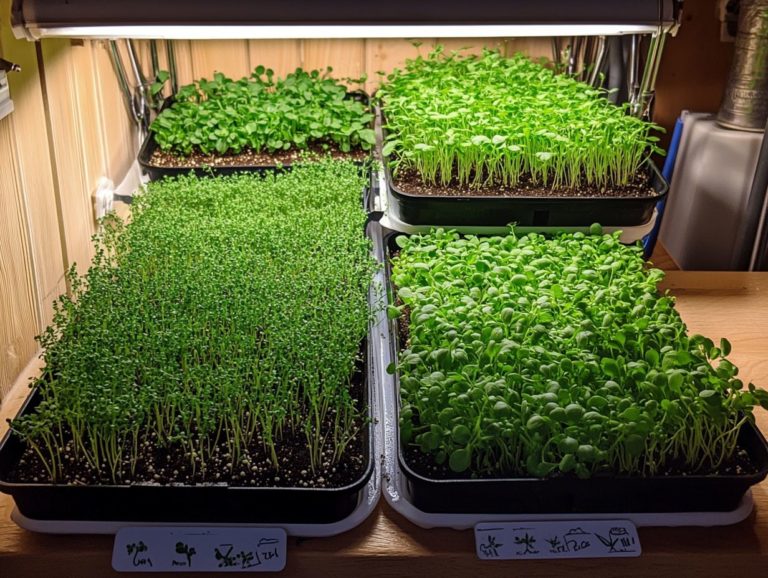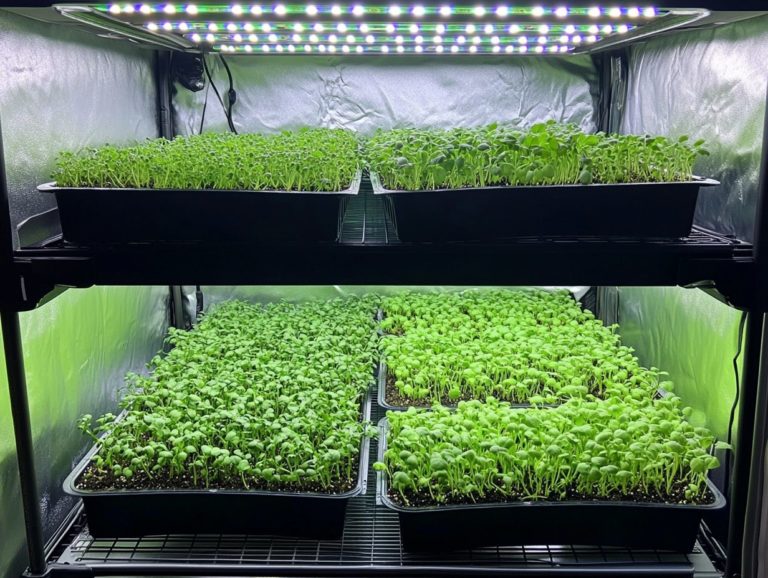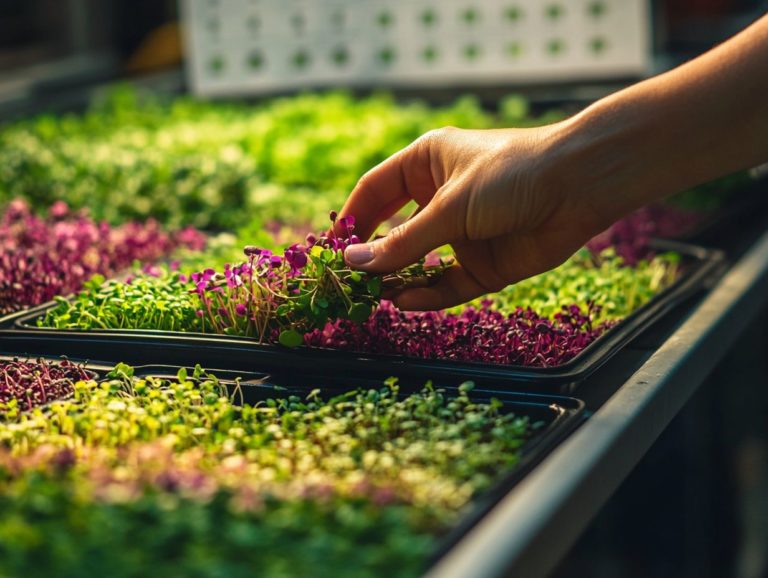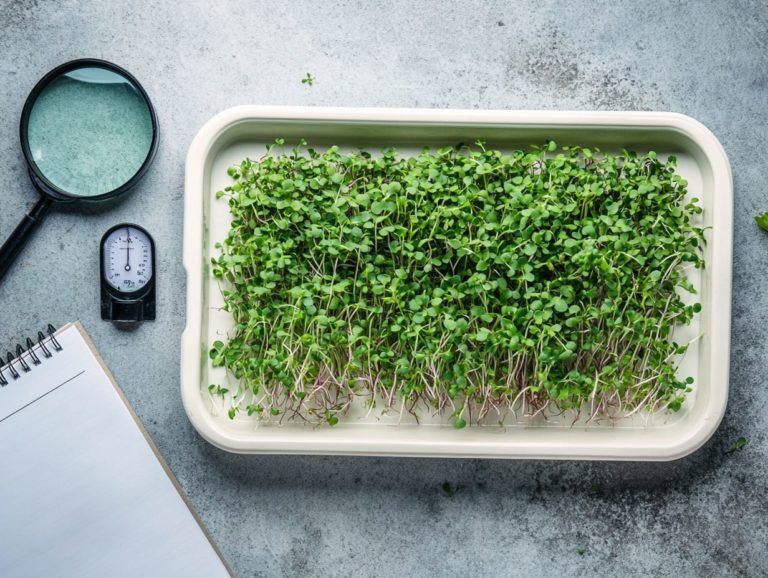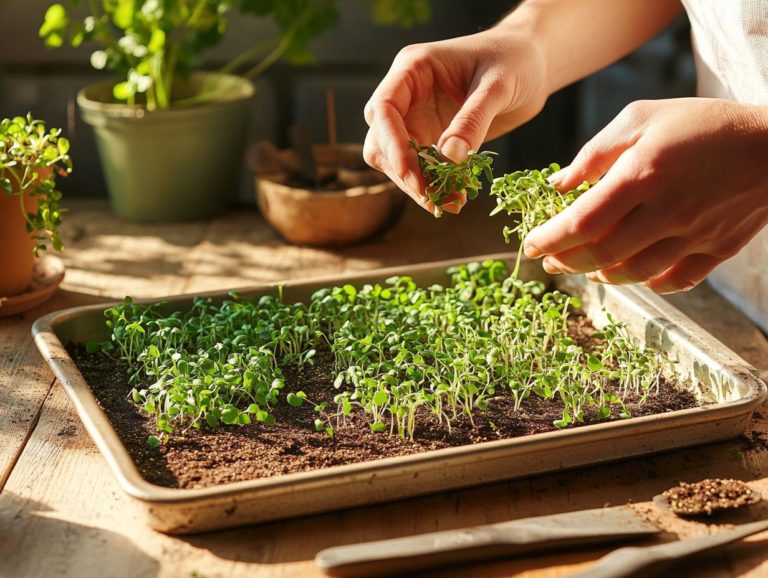Choosing the Right Microgreen Seeds
Microgreens have captured the attention of culinary enthusiasts everywhere! They deliver intense flavors, vibrant colors, and remarkable health benefits in a petite package.
As you embark on the journey of cultivating these rich in nutrients plants at home, understanding how to choose the right microgreen seeds becomes paramount.
This article will delve into what microgreens are and their advantages. It will highlight crucial factors to consider when selecting seeds, introduce popular varieties worth exploring, and offer tips for identifying top-notch seeds.
Immerse yourself in this knowledge to elevate your gardening experience!
Contents
Key Takeaways:
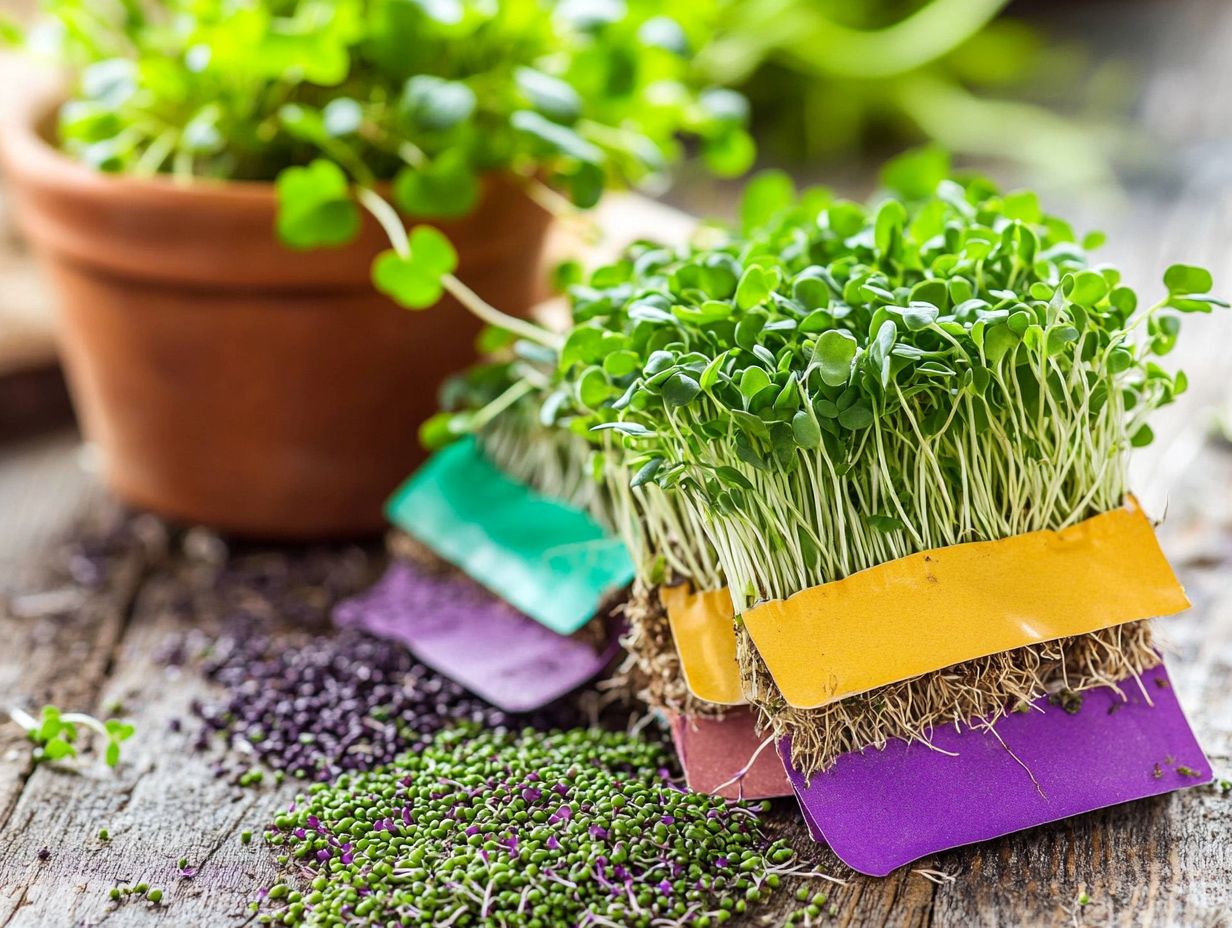
- Choose microgreen seeds based on your desired type, growing conditions, and budget.
- Popular microgreens include sunflower, radish, and broccoli, each with unique flavors and uses.
- Look for signs of good quality seeds and purchase from reputable sources for successful microgreen growth.
What are Microgreens?
Microgreens are young edible plants that you can harvest shortly after germination, typically within 7 to 21 days. They re celebrated not just for their vibrant colors and diverse flavors, but also for their impressive rich nutrient profiles.
These tiny greens, including varieties like basil, sunflower, and radish, offer a robust punch of vitamins, minerals, and antioxidants. They make an excellent choice for elevating a healthy diet. Their rapid growth and quick harvest time also make them a favorite among home gardeners and culinary enthusiasts who love to boost both flavor and nutrition in their dishes.
Definition and Benefits
Microgreens are your ticket to elevating dishes with a burst of flavor and a powerhouse of nutrients! These young plants, harvested at their peak, serve as a concentrated source of vitamins and minerals that can significantly enhance your meals while promoting a healthy diet.
These tiny greens are packed with antioxidants! They support your immune system and boost overall health. Imagine adding sunflower microgreens, which bring a delightful nutty flavor to your salads, or radish microgreens, known for their zesty peppery kick that can elevate any sandwich. You can also explore a quick guide to common microgreen varieties like broccoli microgreens, celebrated for their high sulforaphane content (a compound found in broccoli that may help reduce inflammation), which may even help combat inflammation.
By incorporating a diverse range of these vibrant greens into your meals, you not only create an explosion of flavor but also reinforce a nutrient-rich eating regimen that contributes to long-term health.
Factors to Consider When Choosing Microgreen Seeds
Selecting the right microgreen seeds is essential for your cultivation success and demands careful consideration of several factors. Pay close attention to the seed type, germination rate, and the reputation of your seed suppliers.
Choosing high-quality organic seeds not only guarantees a healthier yield but also enhances the overall quality of your indoor garden. Understanding seed density and growth characteristics can significantly boost your productivity.
Proper seed storage is crucial for maintaining seed viability over time.
Types of Seeds
Microgreen seeds present an array of delightful options, including popular varieties such as basil, sunflower, radish, pea shoots, and kale microgreens. Each type offers its own unique flavors and nutritional benefits that can elevate your culinary creations.
Take basil microgreens, for example. They provide a sweet and aromatic flavor, perfect for enhancing the richness of pasta dishes or adding a fresh touch to salads. Sunflower microgreens bring a nutty crunch to the table, making them an ideal choice for sandwiches and wraps. If you’re looking for a bit of zest, radish microgreens deliver a delightful kick that can transform tacos or soups into something extraordinary. For those interested in maximizing their health benefits, exploring the best microgreens for nutritional value can offer great insights.
Pea shoots, with their crisp texture and subtle sweetness, can be a fantastic addition to stir-fries and smoothies. And let’s not overlook kale microgreens, which are not only packed with nutrients but also offer a slightly peppery taste. They re often incorporated into salads or blended into juices, appealing to health-conscious diners eager to enrich their meals with vibrant greens.
Start growing microgreens today to enhance your meals and health!
Growing Conditions
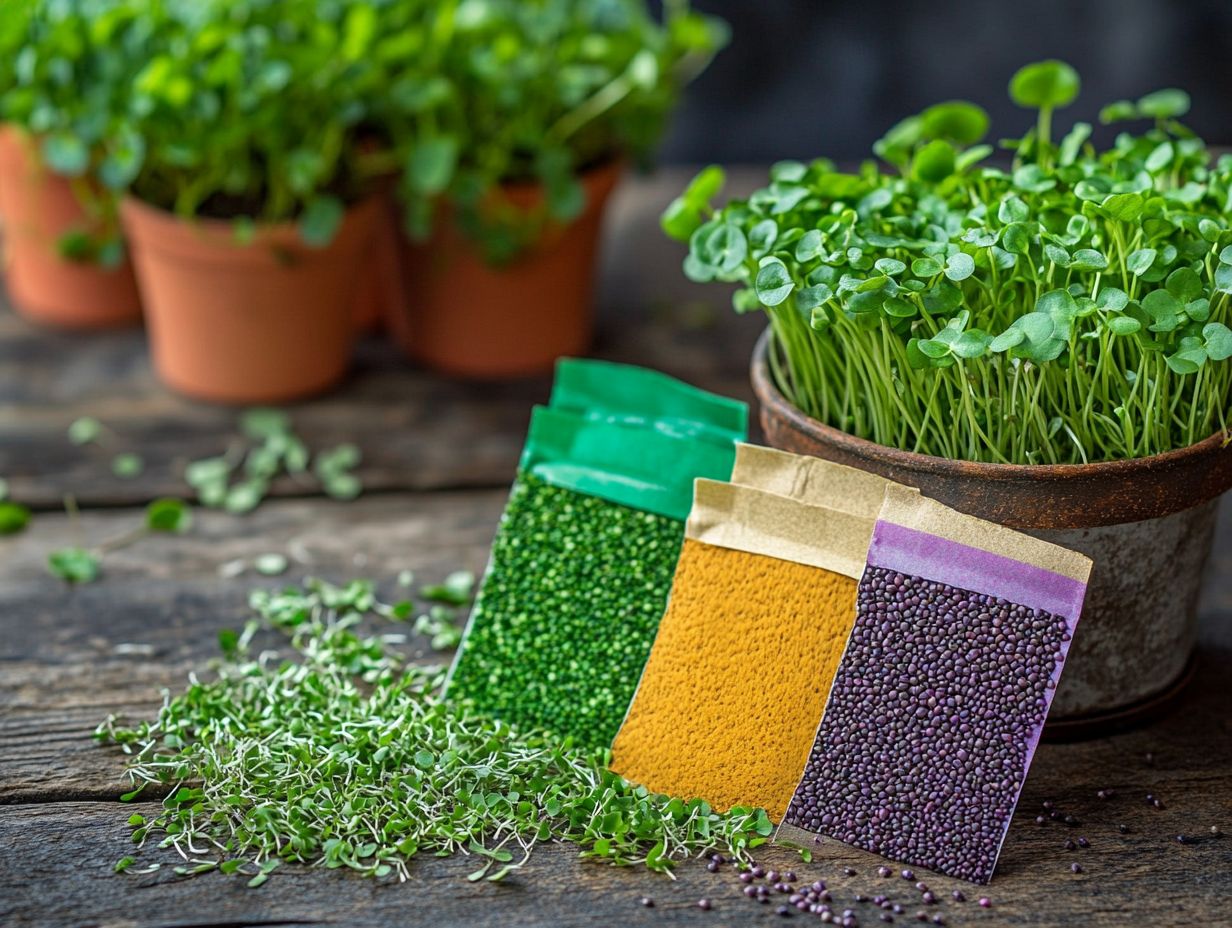
Successful cultivation of microgreens requires an understanding of optimal growing conditions. This includes choosing the right growing medium, using grow lights effectively, and maintaining appropriate temperature and humidity levels for indoor gardening.
Striking the perfect balance among these factors enhances both the growth rate and flavor profile of your greens. For example, well-aerated soil or hydroponics growing plants in a nutrient-rich water solution can work wonders as mediums, ensuring proper drainage and nutrient retention.
Plants thrive under bright, indirect light. Use LED grow lights for 12 to 16 hours a day for the best results. Keeping the temperature steady between 60 and 75 degrees Fahrenheit creates a nurturing environment. Coupled with a humidity level around 40 to 70%, you ll provide the essential moisture that helps those delicate leaves flourish.
Availability and Cost
The availability and cost of microgreen seeds vary dramatically. This is influenced by factors such as your chosen seed suppliers, whether they offer organic or non-GMO options, and the specific variety of microgreens you want.
You’ll discover that quality seeds are available from a range of local nurseries, specialized online retailers, and vibrant farmers markets, each boasting a unique selection. Many enthusiasts appreciate the freshness that comes from purchasing directly from local suppliers, while others find the convenience of online shopping hard to resist. If you’re looking to enhance your salads, consider exploring must-try microgreen varieties that can add flavor and nutrition.
Keep in mind that pricing trends fluctuate with the seasons. Typically, organic seeds come with a higher price tag due to the rigorous farming practices involved.
By comparing costs between conventional and organic varieties, you can make informed decisions that account for both health benefits and the environmental impact of your microgreen gardening journey.
Popular Microgreen Seed Varieties
Popular microgreen seed varieties include basil, cilantro, arugula, broccoli microgreens, and mustard microgreens. Each option boasts a distinct flavor profile and culinary application, elevating your salads and other dishes with vibrant tastes.
Descriptions and Uses
Microgreen varieties like basil and cilantro are not just celebrated for their delightful flavors; they also offer a variety of health benefits, making them critical in your culinary repertoire.
These tiny plants are packed with nutrients, delivering concentrated health benefits compared to their fully grown counterparts. Take arugula microgreens, for example: their delicate, peppery flavor can elevate even the simplest salad or sandwich. If you’re interested in growing your own, check out this guide on how to start microgreens from seed. Meanwhile, radish microgreens add a bright, crisp texture that brings exciting crunch to many dishes.
Beyond enhancing visual appeal, these greens contribute vital vitamins A, C, and K, alongside essential minerals. Integrating microgreens into your meals isn’t just delicious; it’s a simple way to boost your nutrition! To learn more about selecting the right types, check out how to choose microgreen varieties for your garden. Whether you sprinkle them atop tacos or blend them into smoothies, you can transform ordinary recipes into vibrant, nutritious masterpieces.
Tips for Selecting High-Quality Microgreen Seeds
Selecting high-quality microgreen seeds is essential for achieving vigorous growth and a flavorful harvest. Be aware of several critical factors, including how to identify high-quality seeds and why it s important to choose trusted suppliers.
By prioritizing these elements, you set the stage for a successful and rewarding cultivation experience.
Signs of Good Quality Seeds
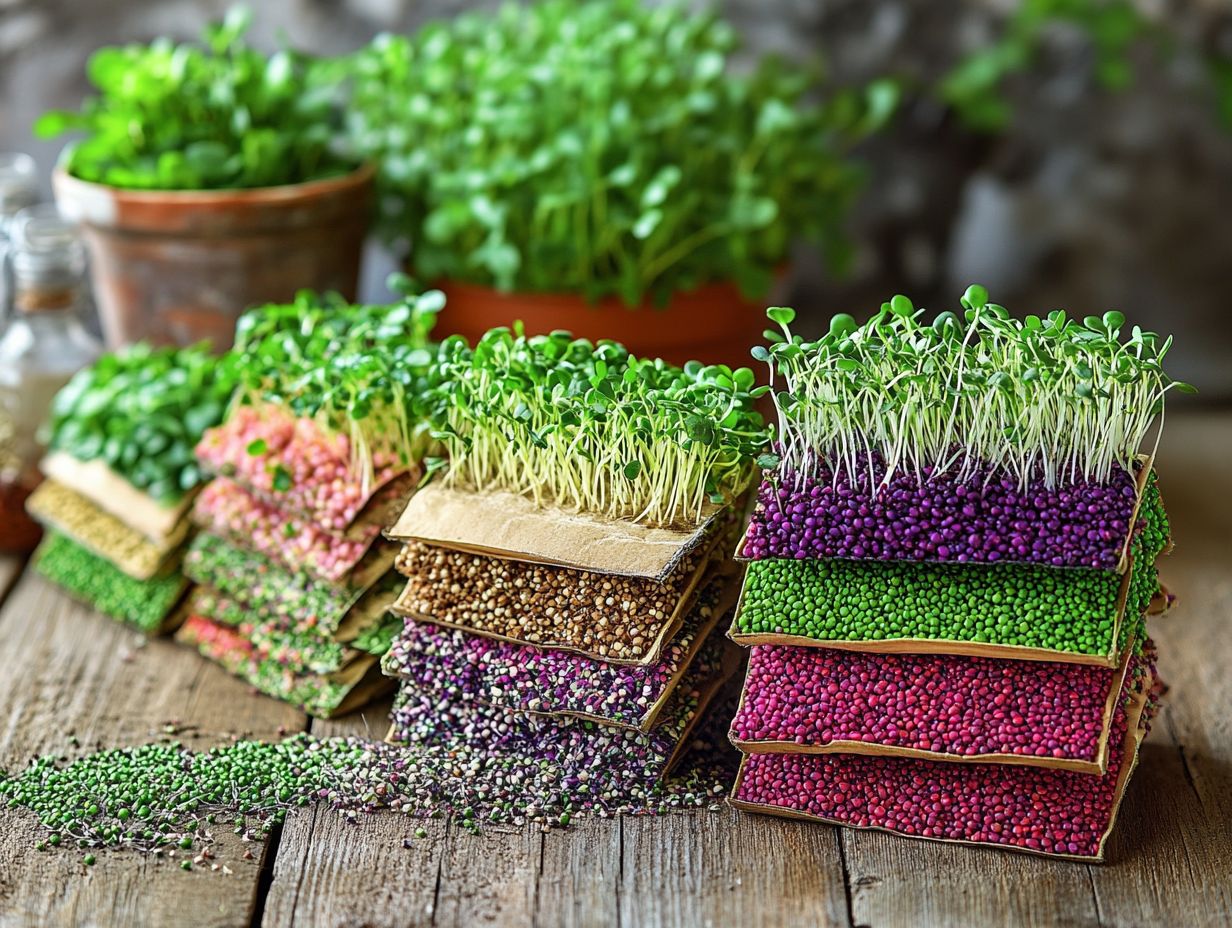
High-quality microgreen seeds are your ticket to a successful harvest. They boast impressive germination rates (the percentage of seeds that sprout) and optimal seed density.
To pinpoint exceptional seeds, look for those from reputable suppliers. They typically provide detailed information about each variety’s germination rates. A germination rate above 90% is ideal, signaling that most seeds will sprout and maximize your yield. For beginners, exploring microgreen varieties can also be beneficial. Pay attention to seed density; uniformity in size and color hints at viability.
Performing a simple germination test at home is wise. Take a small sample, soak it, and observe the results. This little experiment offers valuable insights into your seeds’ potential.
Where to Find Quality Seeds
Finding reputable sellers is essential when purchasing high-quality microgreen seeds. Whether you re interested in organic options or specialized varieties, you’ll discover plenty of exciting options.
By exploring both online marketplaces and local gardening stores, you can uncover many choices that align with your preferences. Websites dedicated to gardening products frequently highlight various suppliers, enabling you to compare reviews, prices, and seed selections easily.
If you lean toward a more hands-on experience, visiting local nurseries can be rewarding. You’ll not only find seeds but also gain insights from knowledgeable staff. To optimize your microgreen garden, it’s crucial to understand how to choose the right soil for microgreen growth, so prioritize reputable sellers known for their commitment to quality and customer satisfaction. This ensures the seeds you acquire will germinate successfully and contribute to your flourishing microgreen garden.
Final Thoughts and Recommendations
Integrating microgreens into your healthy diet elevates flavors and infuses your meals with essential nutrients. These nutrient-dense greens are a valuable addition to your cooking options.
These tiny nutritional powerhouses bring a delightful array of flavors and colors to your dishes, making each meal exciting. By incorporating a variety of microgreens like arugula, basil, or radish, you can enjoy their vibrant aesthetics while reaping impressive health benefits. To improve your yield, consider exploring how to maximize yields from microgreens. Packed with vitamins, minerals, and antioxidants, microgreens can bolster your immune system and potentially lower the risk of chronic diseases.
If you’re considering growing microgreens at home, you’ll find it both simple and gratifying. Start with basic seeds, provide ample light from a grow light, and keep moisture levels just right. For a comprehensive approach, check out this step-by-step guide to sowing microgreens. Soon, you’ll enjoy a flourishing harvest.
Embracing microgreens adds zest to your meals and significantly enhances your overall well-being. They also spark your culinary creativity, especially when utilizing various microgreen varieties to meet your cooking needs. For those interested in starting, check out this guide on how to grow microgreens for beginners.
Frequently Asked Questions
How do I pick the best microgreen seeds for my garden?
Consider the taste, texture, and color of the microgreens, as well as their growth characteristics, ease of growing, and nutrient content.
Are all microgreen seeds the same?
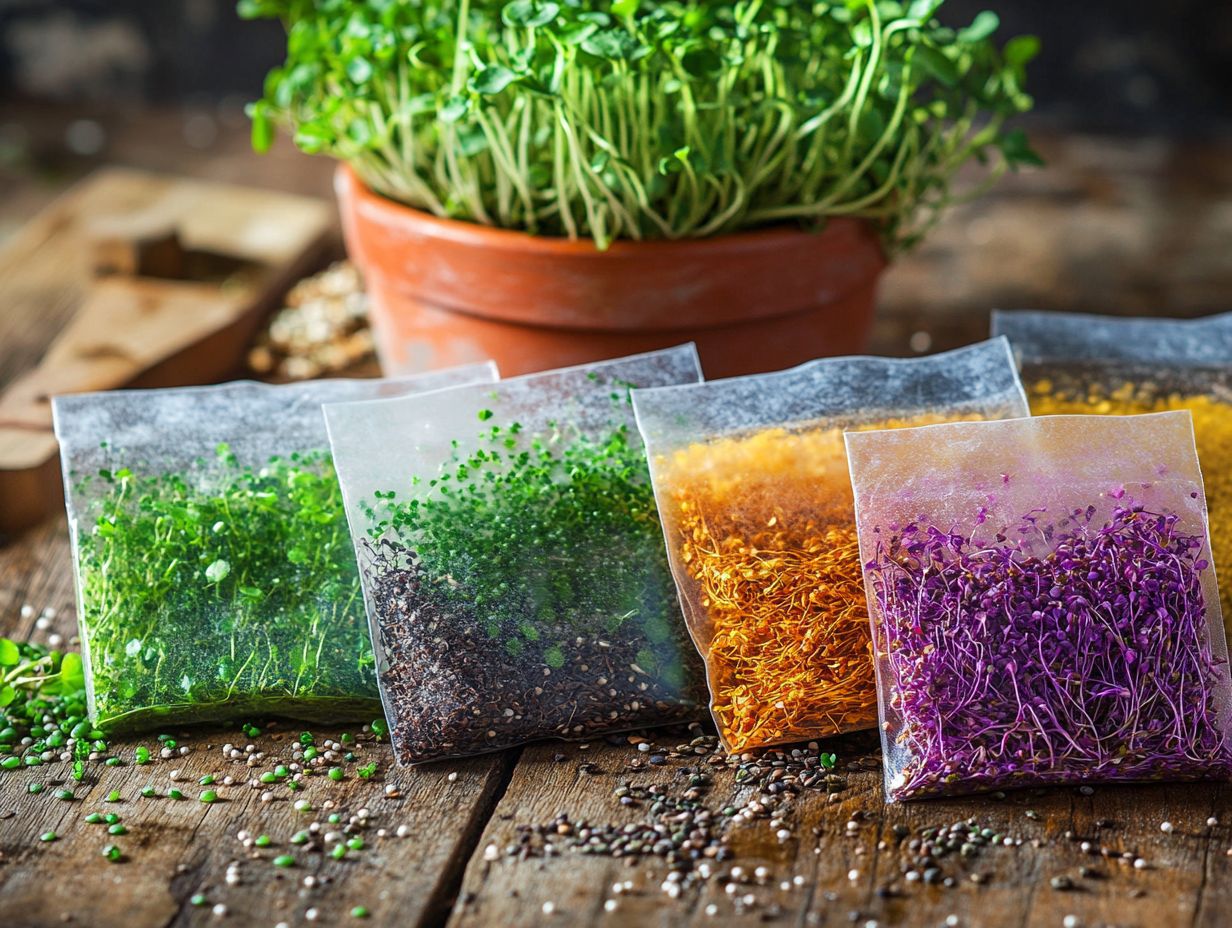
No, not all microgreen seeds are the same. Different types produce different microgreens with varying flavors, textures, and colors. Research and choose the right seeds for the microgreens you want to grow, such as broccoli microgreens or sunflower microgreens.
Can I use any type of seed for microgreens?
Technically, any type of seed can be used for microgreens, including vegetable seeds. However, some seeds are better suited for microgreen growing due to their size, taste, and germination speed. It s best to use seeds specifically labeled for microgreens for optimal results.
Start your microgreen journey today for fresher, healthier meals!
What are some popular microgreen seed choices?
Some popular microgreen seeds include broccoli microgreens, kale microgreens, radish microgreens, and sunflower microgreens. These seeds are known for their quick growth, vibrant colors, and delicious flavors.
How do I know which microgreen seeds are the most nutritious?
Generally, the darker the color of the microgreens, the more nutrients they contain. Seeds like kale, broccoli, and radish are known for their high nutritional profiles. Additionally, research the specific nutrient values of different types of seeds to find the most nutritious options, including non-GMO seeds.
Can I mix different types of microgreen seeds together?
Yes, you can mix different types of microgreen seeds together to create unique flavors and textures. However, make sure to choose seeds that have similar growth times and growing requirements for the best results, considering factors like seed density and growing medium.

